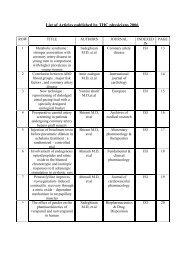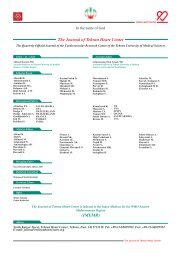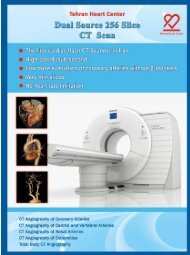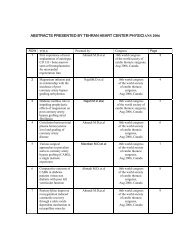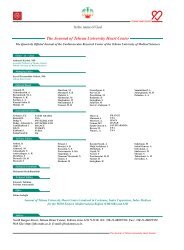THE JOURNAL OF TEHRAN UNIVERSITY HEART CENTER
THE JOURNAL OF TEHRAN UNIVERSITY HEART CENTER
THE JOURNAL OF TEHRAN UNIVERSITY HEART CENTER
Create successful ePaper yourself
Turn your PDF publications into a flip-book with our unique Google optimized e-Paper software.
The Journal of Tehran University Heart Center<br />
Ahmad Yaminisharif et al.<br />
low incidence of embolism compared to left-sided PVT. The<br />
European Society of Cardiology guideline also recommends<br />
thrombolytic therapy for tricuspid PVT, but this guideline<br />
does not mention the NYHA functional class or clot burden. 40<br />
Long-standing symptoms even more than a month should<br />
not make one reluctant to use thrombolytic therapy. 6 If<br />
thrombolytic therapy fails, the presence of a large thrombus<br />
or pannus should be considered, which may require surgical<br />
intervention (thrombectomy or valve replacement).<br />
In contrast to left-sided PVT, there is limited information<br />
about thrombolytic therapy for tricuspid PVT. Various<br />
thrombolytic agents have been used for PVT, including<br />
streptokinase, urokinases, and tissue-type plasminogen<br />
activator (tPA). The choice of the thrombolytic agent depends<br />
on several factors, including cost, time to attain maximal<br />
pharmacologic effect, half-life of the thrombolytic agent,<br />
and hemorrhagic complications. Amongst the above agents,<br />
streptokinase is cheaper and has lower cerebral hemorrhage<br />
rates. In contrast, tPA has a faster effect reversion and<br />
faster reach to maximal pharmacologic effect. 3 Roudaut<br />
et al. indicated that patients treated by streptokinase had a<br />
significantly full success rate compared to patients treated<br />
by tPA or urokinases (86%, 68%, and 59%, respectively).<br />
Nonetheless, combined therapy improved the results of<br />
thrombolytic therapy in all the groups. 41 Also, they concluded<br />
that full success by thrombolytic therapy was higher in<br />
patients in NYHA functional classes I or II; nevertheless,<br />
they did not find a significant difference between patients<br />
with tilting-discs and bileaflet valves, or between patients<br />
with first episode of thrombosis and recurrent thrombotic<br />
episodes groups. 41 The dosage and route of the administration<br />
of thrombolytic therapy are different in various studies.<br />
Hering et al. recommended using streptokinase by starting<br />
a bolus dose of 250,000 IU over thirty minutes, followed<br />
by an intravenous infusion of 100,000 IU per hour (same<br />
as the therapy of our patient in the first episode of PVT),<br />
urokinase by the same protocol used in patients with acute<br />
pulmonary embolism, and t-PA at a dosage of 100 mg given<br />
over a period of two to five hours. 14 Caceres-Loriga et al.<br />
recommended using streptokinase by starting a bolus dose of<br />
250,000 IU over three minutes, followed by an intravenous<br />
infusion of 100,000 IU per hour (maximum duration of<br />
seventy-two hours), urokinase by starting a bolus dose of<br />
4500 U/kg, followed by an intravenous infusion of 4500<br />
U/kg/h (maximum duration of twenty-four to forty-eight<br />
hours), and tPA by starting a bolus dose of 15 mg over five<br />
minutes, followed by an intravenous infusion of 95 mg over<br />
ninety minutes. 3 Manteiga et al. used the short-course of<br />
thrombolytic therapy as a first line for PVT: streptokinase<br />
by starting a bolus dose of 250,000 IU over twenty minutes,<br />
followed by an intravenous infusion of 1,500,000 IU over<br />
ninety minutes, or tPA by starting a bolus dose of 10 mg,<br />
followed by an intravenous infusion of 90 mg over ninety<br />
minutes. They concluded that a successful rate by these<br />
regimes was 82%. 42 However, Alpert recommended another<br />
dose for streptokinase in right-sided PVT (starting a dose of<br />
500,000 IU over twenty minutes, followed by an intravenous<br />
infusion of 1,500,000 IU over ninety minutes). 43 Some<br />
other investigators have used direct intra-atrial infusion of<br />
thrombolytic for PVT. 44, 45 For the first time, Zhang et al.<br />
reported a case of tricuspid PVT, which was successfully<br />
treated by an intra-right atrium infusion of tPA.<br />
Recently, Tenecteplase (a genetically engineered variant<br />
of tPA which has a longer half-life than tPA and is resistant<br />
to inactivation by plasminogen activator inhibitor-1 46 ) has<br />
been utilized for PVT. Our literature search shows that<br />
Tenecteplase has been used in limited case repots for mitral<br />
or aortic PVT. 47-52 Although Tenecteplase has been prescribed<br />
in different doses and via different methods, we used this<br />
thrombolytic according to the dosing regimen employed<br />
for acute myocardial infarction. Data on Tenecteplase for<br />
the treatment of PVT are limited. Still, Melandri et al. in a<br />
review study about patients with acute myocardial infarction<br />
showed that this drug had some advantages compared with<br />
tPA. These advantages included being more fibrin-specific,<br />
usability in a single bolus dose, and having less non-cerebral<br />
bleeding. Be that as it may, mortality rates and intracranial<br />
hemorrhage rates were similar to those of tPA. 46 For the first<br />
time, we reported a successful use of Tenecteplase in our<br />
case 1 for the treatment of two episodes of recurrent tricuspid<br />
PVT. It seems that this drug might be a suitable alternative<br />
for the other types of tPA in the future.<br />
If thrombolytic therapy is successful, a continuous<br />
infusion of unfractionated heparin is indicated and should<br />
be initiated. Moreover, activated partial thromboplastin<br />
time should be maintained at twofold the baseline values,<br />
followed by conversion to oral anticoagulation combined<br />
with Aspirin (50 to 100 mg per day). 39 In contrast to leftsided<br />
PVT, guidelines do not provide a recommended INR<br />
for prostheses in the tricuspid position. 36, 39, 40 For bileaflet<br />
prosthetic valves in the mitral position, a range of 2.5 - 3.5<br />
is recommended, 2.0 - 3.0 in the aortic position for patients<br />
without additional risk factors for thromboembolism. 39<br />
However, Shapira et al. recommended target INR levels of<br />
3.5 - 4.0 for patients with tricuspid prostheses 6 and Zhang<br />
et al., in order to prevent future thrombotic complications<br />
of tricuspid PVT, considered target INR levels of 3.0 - 3.5.<br />
Recurrent tricuspid PVT<br />
A major disadvantage of thrombolytic therapy is the<br />
relatively high incidence of recurrent thrombosis during<br />
follow-up; however, data are limited about rethrombosis<br />
after thrombolytic therapy of tricuspid PVT. Recurrent<br />
rates after thrombolytic therapy vary from 11% to 31%. 3,<br />
53-58<br />
Overall, risk of recurrent thrombosis after thrombolytic<br />
therapy in left-sided prosthetic valves is higher than that in<br />
152



